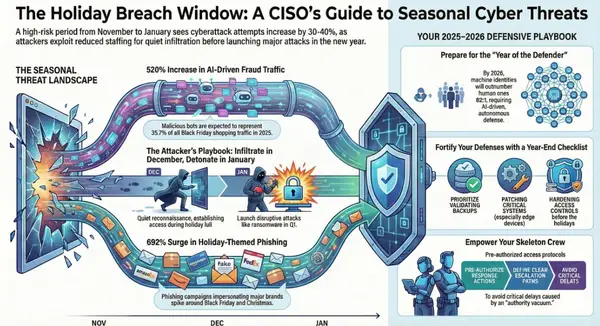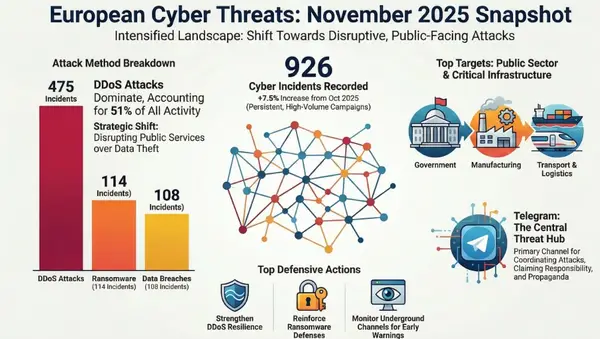Allianz Life Data Breach Exposes Majority of 1.4 Million Customers in Latest Insurance Industry Cyberattack

Bottom Line Up Front: Allianz Life Insurance Company of North America confirmed that hackers accessed personal data from the majority of its 1.4 million customers through a sophisticated social engineering attack on a third-party cloud system. The breach, discovered on July 17, 2025, appears to be linked to the notorious ShinyHunters cybercrime group and represents the latest in a troubling wave of cyberattacks targeting the insurance sector.

What Happened
On July 16, 2025, cybercriminals infiltrated a third-party, cloud-based customer relationship management (CRM) system used by Allianz Life Insurance Company of North America. The attackers used social engineering techniques to gain unauthorized access to personally identifiable data belonging to the majority of Allianz Life's customers, financial professionals, and select employees.
The Minneapolis-based company, a subsidiary of Munich-based Allianz SE, discovered the breach the following day and took immediate action to contain the incident. Allianz Life emphasized that there is no evidence that the company's internal network or other systems were accessed, including its policy administration system.
Scale and Impact
The breach affects an estimated majority of Allianz Life's 1.4 million U.S. customers, making it one of the most significant data breaches in the insurance sector this year. Allianz Life has nearly 2,000 employees in the U.S., with the majority working in Minnesota, and serves as one of five North American subsidiaries of Allianz SE, which serves more than 125 million customers worldwide.
The company filed a disclosure with Maine's Attorney General's Office on Saturday and will offer affected individuals 24 months of identity theft protection and credit monitoring. Customer notifications are expected to begin around August 1, 2025.

The Attack Method: Social Engineering
What is Social Engineering? The attack employed social engineering tactics, which involve manipulating human psychology rather than exploiting technical vulnerabilities. These techniques often include deceptively calling helpdesks or impersonating trusted entities to trick employees into revealing access credentials or granting unauthorized system access.
This method has become increasingly effective against modern security systems because it targets the human element, which is often the weakest link in cybersecurity defenses. Unlike traditional hacking that exploits software vulnerabilities, social engineering attacks are difficult to detect and prevent with conventional technical safeguards.
The ShinyHunters Connection
While Allianz Life declined to answer questions about the threat actor, BleepingComputer learned that the attack is believed to have been conducted by the ShinyHunters extortion group. ShinyHunters is a notorious cybercrime collective that has been responsible for numerous high-profile data breaches.
ShinyHunters' Track Record
ShinyHunters is a black-hat criminal hacker group believed to have formed in 2020 and has been involved in numerous data breaches, with stolen information often sold on the dark web. The group's recent activities include:
2024 Snowflake Campaign: ShinyHunters targeted approximately 165 organizations using Snowflake through account takeover attacks using stolen credentials harvested from historical infostealer infections dating back to 2020. Major victims included:
- Ticketmaster, Santander Bank, and Neiman Marcus
- AT&T, where they compromised call and text metadata of nearly 110 million customers
- PowerSchool, Advance Auto Parts, and Cylance
Other Notable Breaches:
- Microsoft's private GitHub account in 2020, stealing over 500 GB of source code
- Tokopedia (91 million user accounts), Wattpad (270 million user records), and AT&T Wireless (70 million subscribers)

Third-Party Risk Amplified
The Allianz breach highlights the growing cybersecurity risks associated with third-party vendors and cloud-based systems. The attack was isolated to the third-party CRM platform and did not compromise internal systems or insurance policy records directly.
This incident demonstrates how attackers are increasingly targeting vendor relationships as a pathway to access sensitive data. Even when a company's internal security measures are robust, vulnerabilities in third-party systems can provide cybercriminals with access to vast amounts of customer information.
Insurance Industry Under Siege
The Allianz breach is part of a broader pattern of cyberattacks specifically targeting the insurance sector in 2025. Three insurance companies publicly disclosed cyberattacks in just one week in June 2025, including Aflac, Erie Insurance, and Philadelphia Insurance Companies.

Recent Insurance Sector Attacks
Aflac (June 2025): Cybercriminals breached insurance giant Aflac, potentially stealing Social Security numbers, insurance claims, and health information. The company identified suspicious activity on June 12, 2025, and contained the intrusion within hours.
Scattered Spider Connection: Security researchers at Google identified that Scattered Spider, a notorious hacking collective, was actively targeting the insurance sector. The loose group of cybercriminals is considered dangerous and unpredictable, comprised of youths in the U.S. and the UK known for aggressively extorting their victims.
Why Insurance Companies Are Targets
Insurance companies represent attractive targets for cybercriminals because they:
- Store vast amounts of sensitive personal and financial data
- Often have complex IT infrastructures with multiple third-party integrations
- Handle high-value transactions and maintain significant financial reserves
- Are subject to regulatory requirements that may pressure them to pay ransoms quickly
Federal Response and Investigation
Allianz Life notified the FBI immediately after discovering the breach. The FBI's involvement underscores the severity of the incident and the growing federal focus on cybercrime targeting critical infrastructure and financial services.
The timing is particularly significant as federal agencies have been increasingly vocal about the need for enhanced cybersecurity measures across the financial sector, especially following the wave of attacks on insurance companies.
Technical Analysis: The Third-Party CRM Vulnerability
The breach occurred through a cloud-based CRM system, highlighting several key cybersecurity challenges:
Vendor Security Gaps: Third-party systems may not maintain the same security standards as the primary organization, creating potential entry points for attackers.
Social Engineering Effectiveness: The attackers allegedly acquired login credentials using information-stealer malware, then created session tokens with the stolen credentials.
Legacy Credential Risk: Credentials used in similar attacks had not been changed or rotated despite dating back as far as 2020 and remained valid.
Broader Cybersecurity Implications
Supply Chain Security
This incident reinforces the critical importance of supply chain security in the digital age. Organizations must extend their security oversight to include rigorous vetting and monitoring of third-party vendors.
Multi-Factor Authentication Gaps
Over 80% of compromised accounts in similar attacks lacked multi-factor authentication (MFA), meaning successful authentication only required a valid username and password.
Information Stealer Malware Threat
The attack leveraged credentials harvested through information stealer malware variants including VIDAR, RISEPRO, REDLINE, RACOON STEALER, LUMMA, and METASTEALER, demonstrating how historical compromises can enable future attacks.
Industry Response and Future Outlook
Regulatory Scrutiny
The breach may prompt U.S. and international regulators to reevaluate requirements around third-party risk management, breach response timelines, and mandatory customer protections following data exposure.
Market Impact
Munich Re expects the global cyber insurance market to reach $16.3 billion in 2025, driven partly by incidents like this that demonstrate the critical need for comprehensive cyber coverage.
Threat Actor Evolution
Threat actors continue to exploit overlooked SaaS misconfigurations, gaining access to critical systems and sensitive data, suggesting that organizations must focus on configuration management and access controls.
Lessons Learned and Recommendations
For Organizations:
- Strengthen Third-Party Risk Management: Implement rigorous security assessments and ongoing monitoring of vendor systems
- Enhance Social Engineering Defenses: Provide regular training to employees on recognizing and responding to social engineering attempts
- Implement Comprehensive MFA: Require multi-factor authentication across all systems, especially those handling sensitive data
- Credential Hygiene: Regularly rotate credentials and monitor for compromised credentials on the dark web
For Consumers:
- Monitor Credit Reports: Take advantage of the free credit monitoring services offered by affected companies
- Enable Account Alerts: Set up notifications for unusual account activity
- Use Strong, Unique Passwords: Employ password managers to create and maintain unique passwords for all accounts
- Stay Informed: Keep abreast of breach notifications and take recommended protective actions promptly
Looking Ahead
The Allianz Life breach represents more than an isolated incident—it's part of a systematic campaign by sophisticated cybercrime groups targeting the insurance sector. As security expert John Hultquist noted, "Given this actor's history of focusing on a sector at a time, the insurance industry should be on high alert, especially for social engineering schemes which target their help desks and call centers".
As the investigation continues and customer notifications begin, this incident will likely serve as a catalyst for enhanced cybersecurity measures across the insurance industry. The combination of sophisticated threat actors, third-party vulnerabilities, and the high value of insurance industry data creates a perfect storm that requires immediate and sustained attention from both industry leaders and regulators.
The challenge moving forward will be balancing operational efficiency with security resilience while maintaining customer trust in an increasingly digital insurance landscape.









